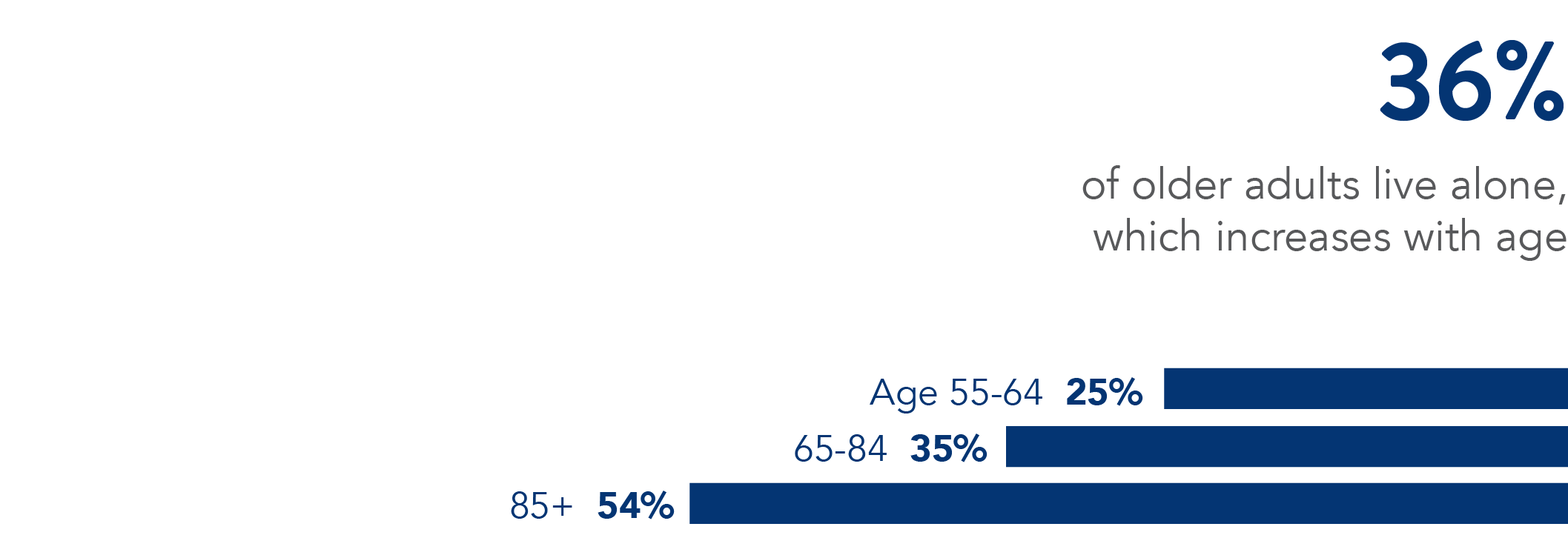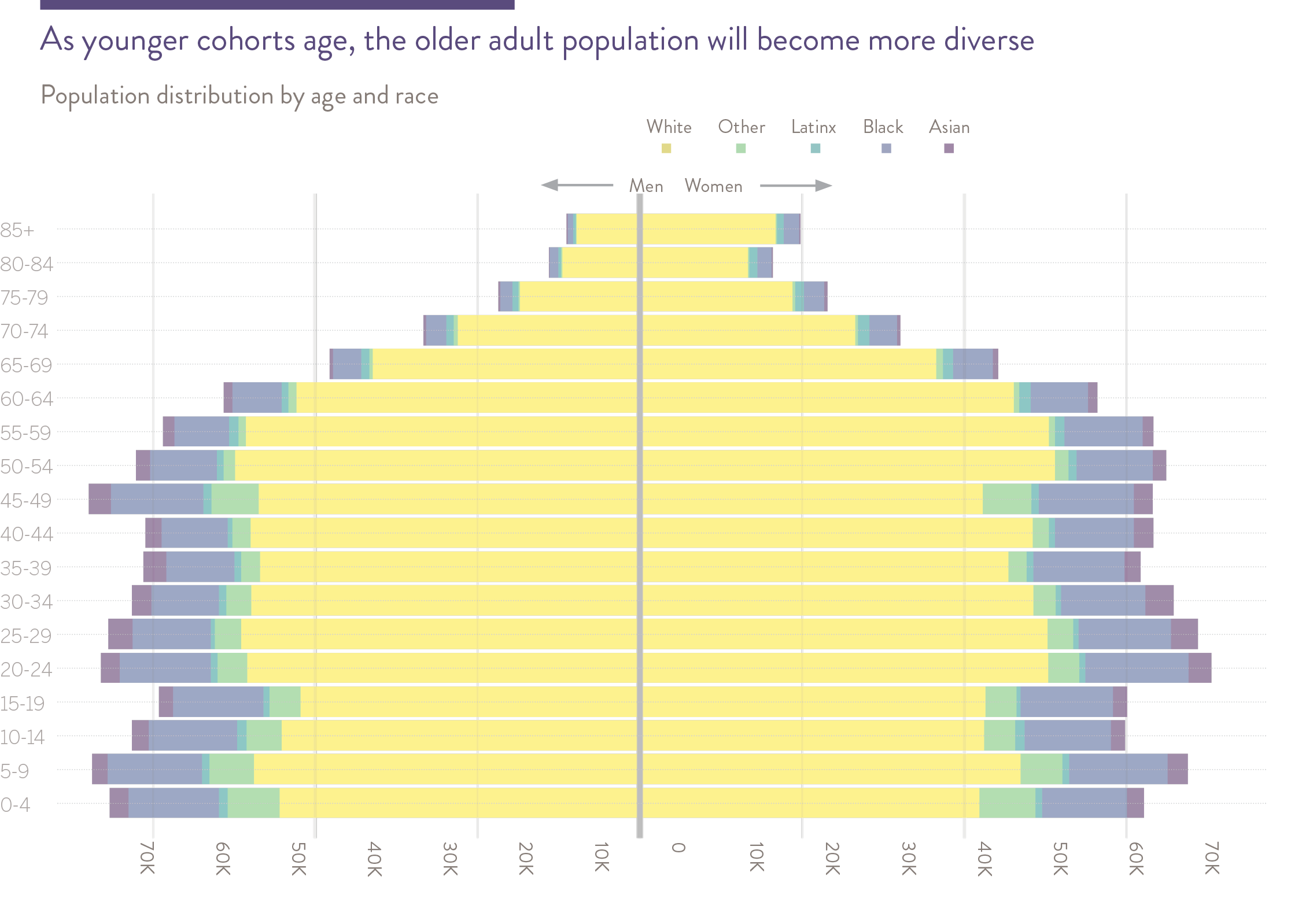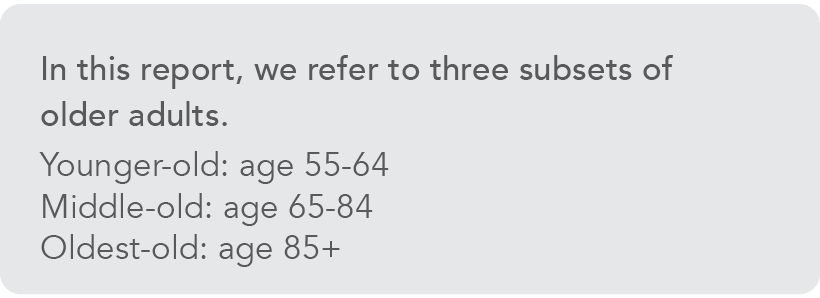Demographics 2022
A growing population of nearly half a million older adults (age 55 and older) live in Central Indiana. This section of the report emphasizes population trends and household characteristics, including socioeconomic indicators.- Our 2022 update shows long-term trends continue: The older adult population grew by 12,000 from the previous data year and became slightly more diverse. Older adults of color increased by 4,300 and now make up 18 percent of the older adult population.
- The older adult population is increasing at over five times the rate of the younger population.
- People of color comprise one in six older adults. The older adult population will become increasingly diverse as the more heterogeneous younger population ages.
- More than one third of older adults live alone.
- Older adults of color are almost three times more likely to experience poverty compared to White older adults.
Current Population

Population Trends


Race and Ethnicity


Households and Families






Income and Poverty



Location of older adults in Central Indiana
This map is interactive. Hover over an area to learn more about the older adult population in each census tract.
Demographics
As the Baby Boomer’s age, the older adult population in Central Indiana increased by 31 percent between 2012 and 2020. In contrast, the population under age 55 increased by six percent. Population increases were significant for all age groups. This is typical in decennial census year, as results from the census inform estimates in the American Community Survey. As of 2020, older adults were one quarter (26 percent) of the Central Indiana population, which is slightly lower than for the state as a whole (29 percent). The oldest-old age group, those age 85 and older, are two percent of the population in Central Indiana. The younger-old (age 55 to 64 years) and the middle-old (age 65 to 84 years) age groups each make up 12 percent of the population.
While older adults in Central Indiana are more diverse than the rest of the state, the majority (82 percent) age 55 and older in Central Indiana are White. The older adult population is less diverse than subsequent generations. One third of those under age 55 (33 percent) are people of color. The racial makeup of older adults will change as this younger, more diverse cohort grows older.


Concentration of older adults experiencing poverty
This map is interactive. Hover over dots to learn more about older adults experiencing poverty in each census tract.
Older Adult Households
Age, race, and ethnicity relate strongly to the kinds of households and families in which older adults live. As householders age, they are more likely to become widowed, less likely to be married and more likely to live alone. Latinx older adults are more likely than older Black adults and older White adults to live in households where more than one generation lives together, and are more likely to be married, making them less likely to live alone.
More than one third (36 percent) older adult households in Central Indiana consist of individuals living alone. The oldest-old (those age 85 and older) are much more likely to be living alone (54 percent) compared to the middle-old (35 percent) and younger-old (25 percent). Black older adult households are more likely to consist of those living alone (45 percent) compared to Latinx older adult households (28 percent) and White older adult households (34 percent).
Younger-old and middle-old households are much more likely to be currently married (43 percent and 36 percent respectively), compared to the oldest-old, of which only 19 percent are married. Black older adults are the least likely to be married (23 percent), compared to Latinx older adults (40 percent) and White older adults (35 percent). Among all older adults in Central Indiana, over one third (32 percent) are divorced, separated or widowed.
Five percent of older adults live in households with their grandchildren. This rate is highest for the younger-old (5.7 percent) and lowest for the oldest-old (2.6 percent). A larger share of Latinx older adults live with their grandchildren (15.0 percent), while this rate is 8.6 percent and 3.9 percent for Black and White older adults, respectively.
Differences between these rates and the 2021 State of Aging Report are attributable to methodology changes. The 2021 and 2022 reports are not comparable for statistics about marriage rates, living alone, or living with grandchildren.



